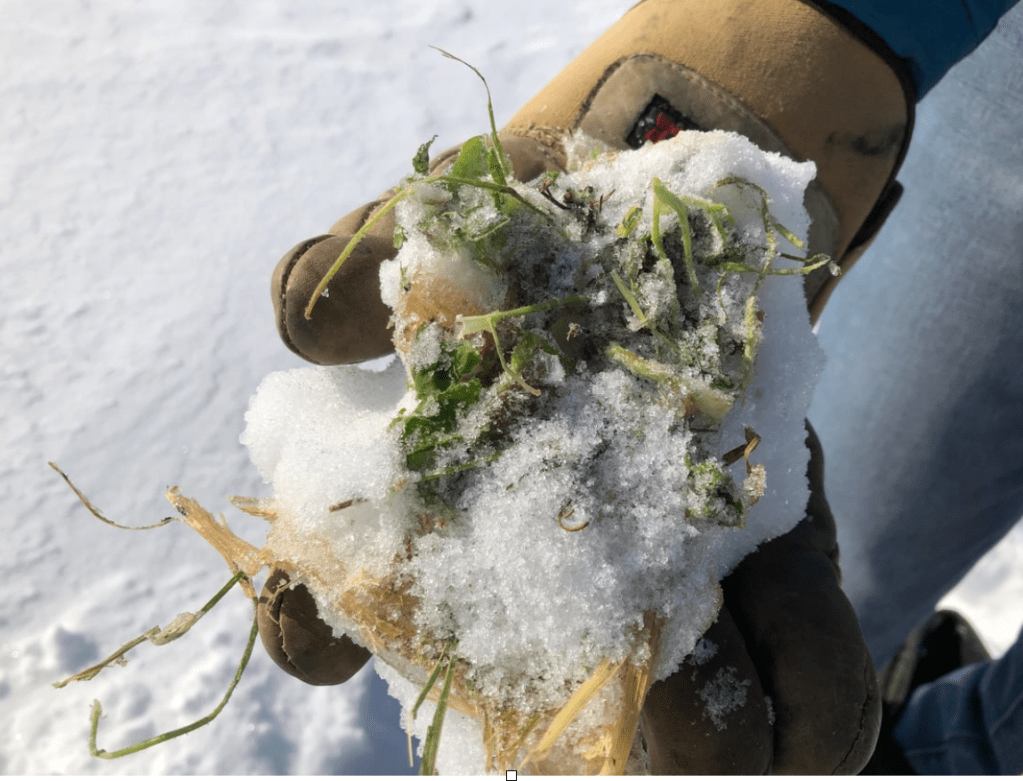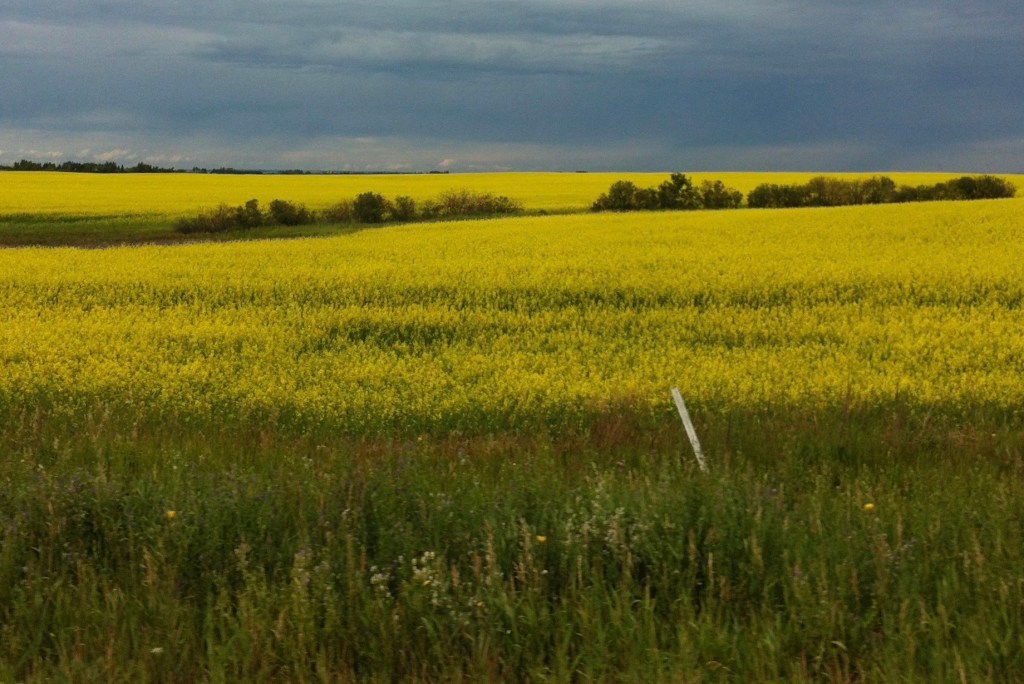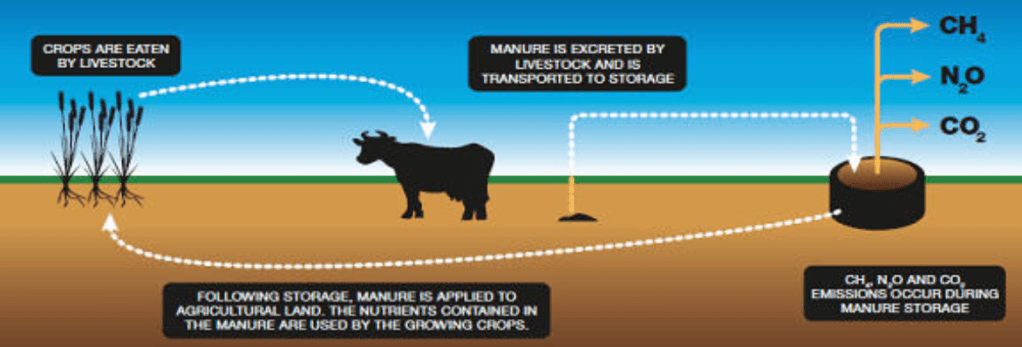Last weeks blog mentioned research in New Zealand on how to reduce the methane cows create using diet supplements called “kowabucha” and we thought that was brilliant and funny. So this week we are looking into innovations in the farming industry in Canada such as vertical hydroponic farms as well as other unconventional or old-fashion agricultural techniques that can sequester carbon while improving soil, including cover crops and rotation of crops.
We read that 10% of Canada’s greenhouse gas emissions are from crop and livestock production, in the form of nitrous oxide, carbon dioxide, methane (CH4). It seems Canada is doing better at sinking the CO2 in the soil as we have been aware of erosion issues for decades. But knowing we can do even more to sink ghgs in the soil is great news. There is more research and action needed with sequestering the nitrous oxide and methane gas.
The federal agency Agriculture and Agri-Food Canada notes that earth’s existing farmland could absorb all of the world’s ghgs for the next 100 years at current rates if properly used.
Vertical Hydroponics

Vertical hydroponics is described as the leading-edge technology to the food sector to produce the extremely fresh, safe, pesticide free, sustainable, local, traceable and package free produce that makes for less food waste. The plants float on rafts while their roots dangle directly into nutrient-rich water, and grow indoors under various LED lights up to 13 layered levels high using elevator equipment to rotate. Growing conditions are consistent all year round, producing a reliable supply of healthy vegetables. There is a large amount of energy use in the lighting and temperature control, so using renewable sources of energy would be required to make this a favourable option.
We had seen vertical farming being used in Europe and wondered about Canada so are glad to read there are several companies developing vertical hydroponics in Canada. ‘We The Roots’, ‘Local Leaf ‘(which is expanding across the country) and ‘Elevate Farms’ (with government contracts in the North) are just three of the larger scale ones, but smaller vertical farms are popping up supplying local grocers, markets and restaurants. When one googles hydroponic vertical farms one mostly finds sites to buy DIY equipment. Vertical farming can be scaled to all sizes of need, and is clearly a budding industry.
“McGill University professor Mark Lefsrud, an expert in food security and urban agriculture, says that, while vertical farming currently accounts for less than 1 per cent of all farming in Canada, within 20 years, “I’d expect it to slowly creep up to around 20 per cent of the total market.””
“In a March report, Ontario’s Greenbelt Foundation identifies vertical farming as a priority to expand fruit and vegetable growth in the region and lists six vertical farms operating in Ontario (not including Elevate Farms): one in Kingsville, two in Guelph, and three in Toronto. All grow leafy greens, herbs, and microgreens (such as kale). The report notes that global investment in vertical farms is estimated at US$3.1 billion; about a third of that takes place in North America.”

“To Youbin Zheng, a professor and expert in controlled environment facilities at the University of Guelph, building more vertical farms in southern Ontario makes sense: “If you look at the Greenbelt and Golden Horseshoe, our land is limited, very limited, but our population has been increasing. If you grow vegetables in the field, there are only a few months in a year you can produce outside. If you grow inside with vertical farming, what you can get is just enormous.” The Greenbelt Foundation report states that, by building up, a vertical farm can produce the equivalent of more than 4,000 square metres of greenhouse space using just 185 square metres of floor space.”
“Proponents also cite the significant benefits of vertical farming when it comes to food security and safety. The farms can be close to major population centres, reducing the need for transportation. In the case of Elevate Farms, Welland’s easy access to transportation routes means lower transportation costs and fresher, more nutrient-rich food for the consumer. Closer monitoring of produce and the fact that it stays within one country’s border may also reduce the risk of contamination. Before the pandemic, Kanellos says, “we had numerous outbreaks of E. coli and salmonella in different products across the supply chain”.”
https://www.tvo.org/article/vertical-farming-is-on-the-rise-in-ontario
Elevate Farms has contracts in the North of Canada where food insecurity is an issue. Although leafy greens cannot sustain the population, the intention is not to try and replace traditional agriculture but to supplement the existing market with what the farm produces. Labour is expensive, and energy costs are high: lighting accounting for about 40 per cent of capital costs so First Nations communities will have a hard time covering this costs without serious subsidies from the government. The start up cost alone is huge.
https://www.tvo.org/article/vertical-farming-is-on-the-rise-in-ontario
What can be grown in vertical hydroponics? So far romaine and other lettuces, arugula, kale, broccoli, strawberries, bok choy, baby spinach, dozens of herbs, including basil, cilantro and parsley are grown in these vertical farms, and there is research on growing other food like blueberries and legumes.
In Edmonton if you wish to purchase hydroponic vegetables for pick up or delivery check out: “Vertical Roots”.
Cover Cropping
Canada’s farmland could increase its absorption of greenhouse gas emissions, experts say. Brent Preston, who run The New Farm in Creemore, Ont., belong to a group calling for new policies and a larger voice for farmers in addressing climate change. He is advocating for a practice known as cover cropping, an ancient but now uncommon technique in which crops are planted during the off season to keep soil healthy and active. Under the snow, the ground is unexpectedly green, with a medley of peas, sunflowers, clover and oats alive and thriving in the dead of winter. The more diversity you have, the healthier the soil is going to be.” While the plants are alive, Preston has no intention of ever harvesting them. When the growing season arrives, he will plow them back into the soil, making way for the salad greens, spinach and cucumbers he produces at his organic farm. “There’s never any bare soil in nature,” Preston says. Cover cropping is a very helpful way to sequester nitrous oxide.
Nick Boisvert, CBC News Feb 20, 2021

How Regenerative Farming Could Help Canada Meet Its New Carbon Emission Targets
Written by Mia Sheldon · CBC News · Posted: May 01, 2021
“Claudia Wagner-Riddle, an agro-meteorologist at the University of Guelph, says cover cropping, integrating livestock and increased diversity are key components to using agriculture to fight climate change through improved soil health.”
Planting crops like alfalfa, oats or winter wheat throughout the year instead of leaving the ground bare over the winter — cover cropping — makes soil healthier. The cover crop might not be feeding physical livestock or feeding people, but it’s feeding the biology below our ground right now. It helps feed microbes below ground that keep the soil healthy and productive.
Brett Israel’s family farm in Wallenstein, Ont., rotates through 20 different types of crops and has reduced tillage to help keep the soil healthy.
Also rotational grazing with livestock encourages plant regrowth, naturally distributing nutrients and allowing roots to grow deeper.
“It can take up to a decade to see the benefits of regenerative farming and carbon sequestration, and the practice has remained a relatively fringe approach to agriculture until recently. But a growing body of research is showing its effectiveness in reducing agricultural emissions and improving the soil.”
“A big hurdle is persuading farmers of the benefits. It’s extra work for the farmers; basically they have to plant the cover crop by the seed without getting an income, because they’re not selling it to feed people or animals. They’re using it to feed the soil.”
“Another issue hampering wider adoption has been the difficulty of quantifying the economic and environmental impact of regenerative farming, because hard data has been scarce. This is being researched now. General Mills began working with farmers across North America in 2019 to advance regenerative agriculture over about 400,000 hectares, a project that includes 45 oat farmers in Saskatchewan. The company offers soil testing and coaching to participating farmers, to help offset its own carbon footprint.”
https://www.cbc.ca/news/canada/agriculture-emissions-reduction-strategy-1.5993201
Barriers to Change in Farming Practises
“The federal agency Agriculture and Agri-Food Canada notes that earth’s existing farmland could absorb all of the world’s ghgs for the next 100 years at current rates if properly used. But according to Farmers for Climate Solutions, the existing system of industrial agriculture makes it impossible to realize the carbon fighting potential of Canada’s 160 million acres of farmland. The group points to soil tilling, chemical products, fossil fuel usage and low biodiversity on farms as key areas that must be improved upon. Failing to do so, they argue, will prevent the nation’s farmland from reducing carbon and make farms more vulnerable to the effects of climate change. “It’s really impacting our ability to grow food,” said Flies, pointing to the longer droughts and unpredictable weather making it harder for Canadian farmers to operate.”
“While Geitmann, a professor at McGill University’s plant sciences program, hailed the coalition’s “ambitious” plan to tackle climate change, she noted that several major obstacles could make it hard to achieve its goals. Chiefly, she pointed to potentially higher costs and the challenges of implementing new practices that have been in place for decades. Moving away from soil tilling, for example, may require a more laborious system of removing weeds from soil that could be challenging to some farmers.”

“Bringing those changes to life will likely require new federal incentives to help farmers, Geitmann said. The Canadian Federation of Agriculture also called the plan to become carbon neutral “prohibitively costly” without policy changes such as exempting farmers from the federal carbon tax. Farmers for Climate Solutions also acknowledge that the powerful chemical and fertilizer industry will likely resist widespread change that points farmers away from its products.”
“Paul Slomp, who raises beef cattle in Saint-André-Avellin, Que., said his farm has already moved away from chemicals and artificial feeds. His 200 cows now graze exclusively on grass, which he manages with the goal of maximizing the land’s ability to capture carbon. He questioned the worries around higher costs, and said he’s now making more money than he did before the changes. “Because we’re reducing the amount of input that we need to purchase, we’re actually able to generate a much better profit margin,” said Slomp, who is not a member of Farmers for Climate Solutions. “The cows are meant to do this; they thrive in a system like ours, and it can be quite profitable.””
https://www.cbc.ca/news/canada/toronto/farmers-for-climate-solutions-launch-1.5458676
What Information is Available on the Canadian Government Web Site
(We collected information in this next section from the site https://cutt.ly/kbUKw7S, which is a very informative Government of Canada-Agriculture and the Environment site.)
Ways to Reduce Nitrous Oxide
Cover cropping is just one way to reduce NO2.
Since N2O is produced mostly from excess available nitrogen in soils, another way to suppress emissions of this gas is to apply fertilizer judiciously: adding just enough, at the right place and time, to meet crop demands, but avoiding excess amounts left over. This can reduce fertilizer costs to producers and reduce the amount of nitrogen lost through excess fertilizer application.
Fertilizer can be used more efficiently by:
- adjusting fertilizer rates to coincide with plant needs
- placing fertilizer near plant roots (but not too deep in the soil)
- applying fertilizer several times each year, rather than only once
- using slow-release forms

Similarly, using manure efficiently can also help limit N2O emissions-not only because less is released from the manure, but also because less fertilizer now needs to be used. Perhaps the most fundamental way of reducing N2O from manures is to alter feeding rations so that less nitrogen is excreted in urine and feces in the first place. (Should we warn the cows that they are about to go on a new diet?)
Other practices that can sometimes reduce N2O emissions from farms include:
- greater use of legumes as a nitrogen source
- use of cover crops (sown between successive crops) to remove excess available nitrogen
- avoiding use of summer fallow (leaving the land unplanted, with no crop nitrogen uptake, for a season)
- adjusting tillage intensity (sometimes, but not always, no-till practices can reduce emissions)
Despite much progress, the nitrogen cycle on farms still results in the leakage of N2O and reducing these leaks remains a research priority.
What Farmers Can Do To Enhance The CO2 Sink
To reduce CO2 farmers must basically consider three things:
- increase plant yield (photosynthesis);
- increase the proportion of fixed carbon added to soil; or
- slow the rate of organic matter decomposition.

Here is a list of things that can be done:
- Reduce in tillage
- Restore degraded land
- Improve pasture management
- Reduce fallow periods
- Add animal manures to the soil
- Crop residue management
- Use legumes and/or grasses in crop rotations
- Convert marginal crop land to perennial grass or trees
- Use rotational grazing and high-intensity/short duration grazing
- Plant shrubs and trees as shelterbelts
- Restore wetlands
In addition to sequestering carbon in the soil, these practices also increase soil productivity, enhance the quality of water running off or draining from agricultural land, and provide a more hospitable environment for wildlife inhabiting agricultural lands.These practices can also help improve profitability. For example, minimum tillage increases energy efficiency by reducing machinery use. Improved crop varieties and crop fertilization can increase yields and soil carbon.
Good news, Canadian croplands have been a net sink for CO2 starting in about 1990. However, until recently the removals on croplands were offset by carbon losses from forests and grasslands recently converted to cropland. It is only since about 2000 that agricultural lands have been a net sink for CO2 when land use change is taken into account.The annual total GHG emissions from farms in Canada have increased from 1990 to 2009 with the main driver is the increase in the beef and swine populations, although they have stabilized in recent years.
Ways Farmers Can Reduce Methane

Beyond altering the diet of cows, methane emissions can be reduced indirectly by choosing management practices that enhance productivity:
- extending lactation periods of dairy cows
- using more efficient breeds
- improving reproductive performance
- increasing rates of gain in beef animals so they reach the market sooner
While these practices may not reduce emissions per animal per day, they can lower the amount of CH4 emitted per kilogram of milk or meat produced. Research has also shown that CH4 from manures can be reduced. Management practices that can be effective include:
- aerating manure
- storing manure at low temperatures (below ground)
- removing manure from storage more frequently
- using bedding material to improve aeration
- composting manure
- using biological filters
- trapping the CH4 (methane) and burn it as fuel

Edmonton Root For Trees: Deadline for Volunteers to Register
Edmonton Root for Trees is accepting volunteers to plant trees in the city. There will be a sign up online on May 25 so mark your calendar. I see they will be planting trees in Blackmud Ravine area, which is the closest area for me to volunteer, but there are various locations around the city. Check out their website.


Vertical hydroponics will help create a greener world. Thank you 😊
LikeLike